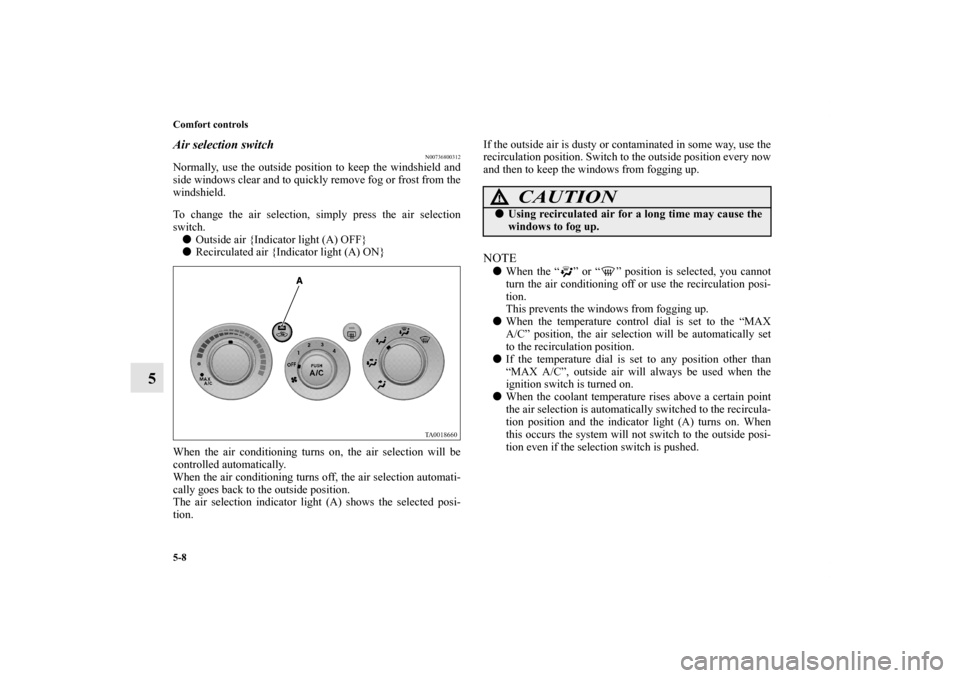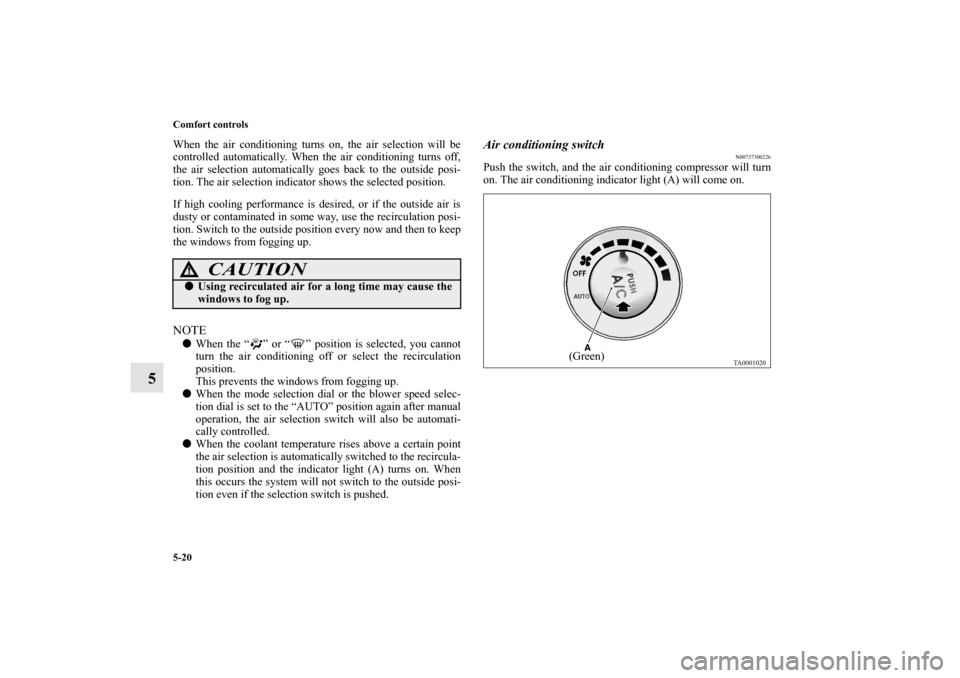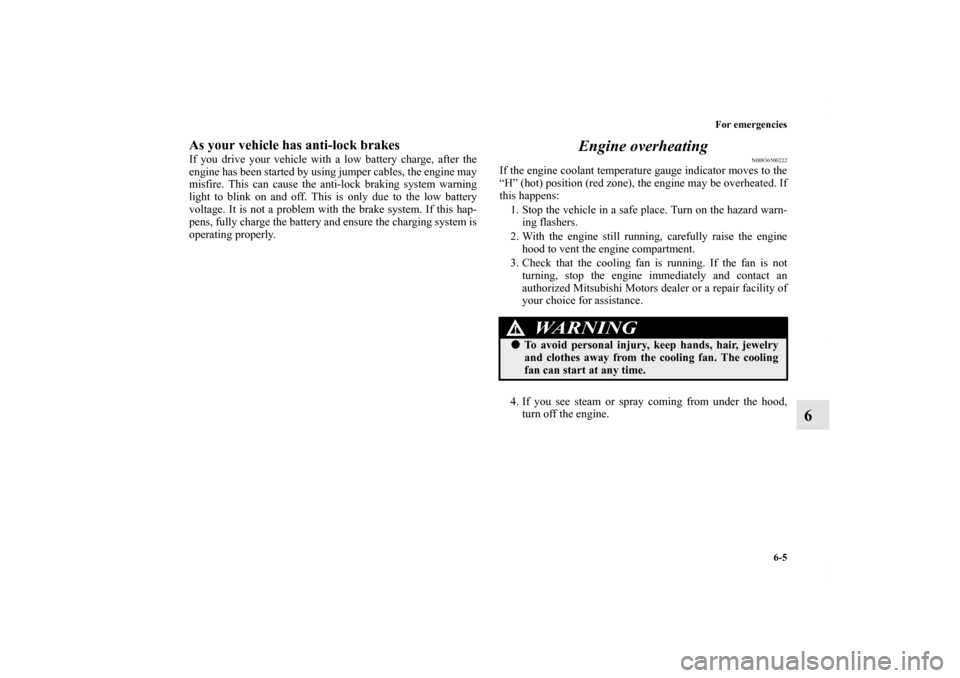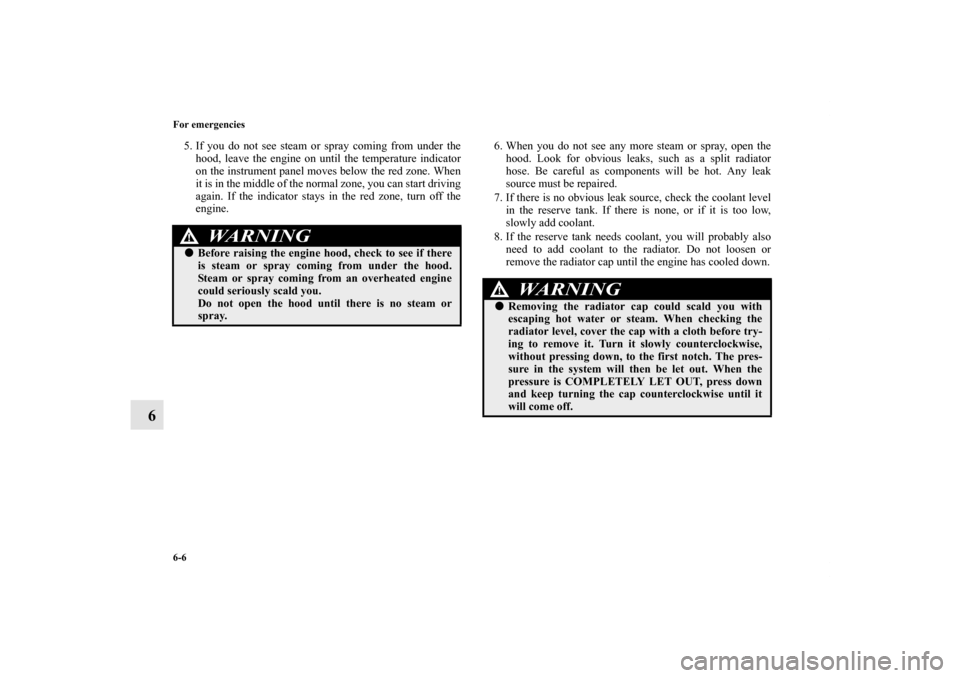Page 326 of 514
Comfort controls
5-7
5
Temperature control dial
N00736600147
Turn the temperature control dial clockwise to make the air
warmer. Turn it counterclockwise to make the air cooler. NOTE�While the engine coolant temperature is low, the tempera-
ture of the air from the heater will be cool/cold until the
engine warms up, even if you have selected warm air with
the dial.
�For instructions on how to use the “MAX A/C” position
(A), see “For quick cooling” on page 5-10.
Mode selection dial
N00736700148
To change the position and amount of air flowing from the
vents, turn the mode selection dial. (Refer to “Changing the
mode selection” on page 5-3.)
BK0121600US.book 7 ページ 2010年4月12日 月曜日 午前10時39分
Page 327 of 514

5-8 Comfort controls
5
Air selection switch
N00736800312
Normally, use the outside position to keep the windshield and
side windows clear and to quickly remove fog or frost from the
windshield.
To change the air selection, simply press the air selection
switch.
�Outside air {Indicator light (A) OFF}
�Recirculated air {Indicator light (A) ON}
When the air conditioning turns on, the air selection will be
controlled automatically.
When the air conditioning turns off, the air selection automati-
cally goes back to the outside position.
The air selection indicator light (A) shows the selected posi-
tion.If the outside air is dusty or contaminated in some way, use the
recirculation position. Switch to the outside position every now
and then to keep the windows from fogging up.
NOTE�When the “ ” or “ ” position is selected, you cannot
turn the air conditioning off or use the recirculation posi-
tion.
This prevents the windows from fogging up.
�When the temperature control dial is set to the “MAX
A/C” position, the air selection will be automatically set
to the recirculation position.
�If the temperature dial is set to any position other than
“MAX A/C”, outside air will always be used when the
ignition switch is turned on.
�When the coolant temperature rises above a certain point
the air selection is automatically switched to the recircula-
tion position and the indicator light (A) turns on. When
this occurs the system will not switch to the outside posi-
tion even if the selection switch is pushed.
CAUTION
!�Using recirculated air for a long time may cause the
windows to fog up.
BK0121600US.book 8 ページ 2010年4月12日 月曜日 午前10時39分
Page 337 of 514
5-18 Comfort controls
5
NOTE�While the engine coolant temperature is low, the tempera-
ture of the air from the heater will be cool/cold until the
engine warms up, even if you have selected warm air with
the dial.
Mode selection dial
N00737100123
To change the position and amount of air flowing from the
vents, turn the mode selection dial. (Refer to “Changing the
mode selection” on page 5-3.)
BK0121600US.book 18 ページ 2010年4月12日 月曜日 午前10時39分
Page 339 of 514

5-20 Comfort controls
5
When the air conditioning turns on, the air selection will be
controlled automatically. When the air conditioning turns off,
the air selection automatically goes back to the outside posi-
tion. The air selection indicator shows the selected position.
If high cooling performance is desired, or if the outside air is
dusty or contaminated in some way, use the recirculation posi-
tion. Switch to the outside position every now and then to keep
the windows from fogging up.NOTE�When the “ ” or “ ” position is selected, you cannot
turn the air conditioning off or select the recirculation
position.
This prevents the windows from fogging up.
�When the mode selection dial or the blower speed selec-
tion dial is set to the “AUTO” position again after manual
operation, the air selection switch will also be automati-
cally controlled.
�When the coolant temperature rises above a certain point
the air selection is automatically switched to the recircula-
tion position and the indicator light (A) turns on. When
this occurs the system will not switch to the outside posi-
tion even if the selection switch is pushed.
Air conditioning switch
N00737300226
Push the switch, and the air conditioning compressor will turn
on. The air conditioning indicator light (A) will come on.
CAUTION
!�Using recirculated air for a long time may cause the
windows to fog up.
(Green)
BK0121600US.book 20 ページ 2010年4月12日 月曜日 午前10時39分
Page 404 of 514

For emergencies
6-5
6
As your vehicle has anti-lock brakesIf you drive your vehicle with a low battery charge, after the
engine has been started by using jumper cables, the engine may
misfire. This can cause the anti-lock braking system warning
light to blink on and off. This is only due to the low battery
voltage. It is not a problem with the brake system. If this hap-
pens, fully charge the battery and ensure the charging system is
operating properly.
Engine overheating
N00836500222
If the engine coolant temperature gauge indicator moves to the
“H” (hot) position (red zone), the engine may be overheated. If
this happens:
1. Stop the vehicle in a safe place. Turn on the hazard warn-
ing flashers.
2. With the engine still running, carefully raise the engine
hood to vent the engine compartment.
3. Check that the cooling fan is running. If the fan is not
turning, stop the engine immediately and contact an
authorized Mitsubishi Motors dealer or a repair facility of
your choice for assistance.
4. If you see steam or spray coming from under the hood,
turn off the engine.
WA R N I N G
!�To avoid personal injury, keep hands, hair, jewelry
and clothes away from the cooling fan. The cooling
fan can start at any time.
BK0121600US.book 5 ページ 2010年4月12日 月曜日 午前10時39分
Page 405 of 514

6-6 For emergencies
6
5. If you do not see steam or spray coming from under the
hood, leave the engine on until the temperature indicator
on the instrument panel moves below the red zone. When
it is in the middle of the normal zone, you can start driving
again. If the indicator stays in the red zone, turn off the
engine.6. When you do not see any more steam or spray, open the
hood. Look for obvious leaks, such as a split radiator
hose. Be careful as components will be hot. Any leak
source must be repaired.
7. If there is no obvious leak source, check the coolant level
in the reserve tank. If there is none, or if it is too low,
slowly add coolant.
8. If the reserve tank needs coolant, you will probably also
need to add coolant to the radiator. Do not loosen or
remove the radiator cap until the engine has cooled down.
WA R N I N G
!�Before raising the engine hood, check to see if there
is steam or spray coming from under the hood.
Steam or spray coming from an overheated engine
could seriously scald you.
Do not open the hood until there is no steam or
spray.
WA R N I N G
!�Removing the radiator cap could scald you with
escaping hot water or steam. When checking the
radiator level, cover the cap with a cloth before try-
ing to remove it. Turn it slowly counterclockwise,
without pressing down, to the first notch. The pres-
sure in the system will then be let out. When the
pressure is COMPLETELY LET OUT, press down
and keep turning the cap counterclockwise until it
will come off.
BK0121600US.book 6 ページ 2010年4月12日 月曜日 午前10時39分
Page 406 of 514
For emergencies
6-7
6
9. Start the engine, and slowly add coolant, up to the bottom
of the filler neck. Use plain water if you have to (and
replace it with the right coolant as soon as possible).
10. Replace the radiator cap and tighten it fully. Check the
temperature indicator. You can drive when the indicator
returns to the normal zone.
11. Have your vehicle checked by your authorized Mitsubishi
Motors dealer or a repair facility of your choice.
Tools and jack
N00836600034
StorageTools are stowed beneath the luggage floor board of the lug-
gage compartment.
The jack is stored under the floor carpet behind the rear seat.1- Jack
2- Tools (Vehicles with compact spare tire)
3- Tools (Vehicles with normal spare tire)
BK0121600US.book 7 ページ 2010年4月12日 月曜日 午前10時39分
Page 428 of 514

7
Vehicle care and maintenance
Service precautions . . . . . . . . . . . . . . . . . . . . . . . .7- 2
Catalytic converter . . . . . . . . . . . . . . . . . . . . . . . . .7- 3
Engine hood . . . . . . . . . . . . . . . . . . . . . . . . . . . . . .7- 4
View of the engine compartment . . . . . . . . . . . . . .7- 6
Engine oil and oil filter . . . . . . . . . . . . . . . . . . . . .7- 6
Engine coolant . . . . . . . . . . . . . . . . . . . . . . . . . . . .7- 9
Air cleaner filter . . . . . . . . . . . . . . . . . . . . . . . . . . .7- 11
Automatic transaxle fluid. . . . . . . . . . . . . . . . . . . .7- 12
Transfer oil (All-wheel drive models) . . . . . . . . . .7- 13
Rear axle oil (All-wheel drive models) . . . . . . . . .7- 14
Washer fluid . . . . . . . . . . . . . . . . . . . . . . . . . . . . . .7- 14
Brake fluid . . . . . . . . . . . . . . . . . . . . . . . . . . . . . . .7- 15
Power steering fluid . . . . . . . . . . . . . . . . . . . . . . . .7- 16
Battery . . . . . . . . . . . . . . . . . . . . . . . . . . . . . . . . . .7- 16
Tires . . . . . . . . . . . . . . . . . . . . . . . . . . . . . . . . . . . .7- 20
Brake pedal free play . . . . . . . . . . . . . . . . . . . . . . .7- 29
Parking brake . . . . . . . . . . . . . . . . . . . . . . . . . . . . .7- 30
Wiper blades . . . . . . . . . . . . . . . . . . . . . . . . . . . . .7- 31
Emission-control system maintenance. . . . . . . . . .7- 31
General maintenance . . . . . . . . . . . . . . . . . . . . . . .7- 33
For cold and snowy weather . . . . . . . . . . . . . . . . .7- 35Fuse links. . . . . . . . . . . . . . . . . . . . . . . . . . . . . . . . 7- 36
Fuses . . . . . . . . . . . . . . . . . . . . . . . . . . . . . . . . . . . 7- 36
Replacement of light bulbs . . . . . . . . . . . . . . . . . . 7- 44
Vehicle care precautions . . . . . . . . . . . . . . . . . . . . 7- 57
Cleaning the inside of your vehicle . . . . . . . . . . . . 7- 58
Cleaning the outside of your vehicle . . . . . . . . . . . 7- 60
BK0121600US.book 1 ページ 2010年4月12日 月曜日 午前10時39分